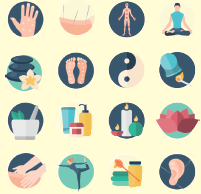A Brief Guide to Alternative & Complementary Medicines
In general, the term “alternative therapy” refers to any health treatment not standard in Western medical practice. Beyond that, complementary and alternative therapies are difficult to define because there are many types of them such long term diet, exercise, hypnosis and acupuncture. Scientists discuss the advantages and disadvantages of alternative therapies. Scientists must do more research to discover the results. Still, people are very interested in them. Here is a brief introduction to some of the most popular alternative and complementary medicines:
Acupuncture
Though “acupuncture” may immediately bring needles to mind, the term actually describes a large group of procedures that stimulate specific points on the body. Used by millions of Americans, it is applied by a practitioner using thin needles that penatrate the skin or by using electric stimulation. Although very popular, many people are still against it. Some studies find it helpful for chronic pain and depression, but evidence on all counts is not clear.
Aromatherapy
Aromatherapy uses essential oils (concentrated extracts from the roots, leaves, seeds, or blossoms of plants) to heal the pain. The oils can be inhaled, massaged into the skin or (in rare cases) taken by mouth, and each has a specific purpose: Some are used to treat infections; others are used to relax people. Studies suggest that aromatherapy might reduce pain, depression, and anxiety, but scientists should research more to fully understand its uses and benefits.
Reiki
Reiki is a form of energy healing based on the idea that a “life force energy” flows through everyone’s body. According to this philosophy, sickness and stress are signs that life force energy is low. On the other hand, energy, health, and happiness shows a strong life force. In a Reiki session, a practitioner tries to “transfer” life energy to the person by placing his or her hands lightly on the patient’s body or a slight distance away from the body (Reiki can also be performed long-distance). The purpose is to relax, speed heal, reduce pain, and generally improve the person’s wellbeing. For the most part, there are no rules for Reiki practitioners. Some people find therapeutic touch to be an effective form of treatment; some don’t.

